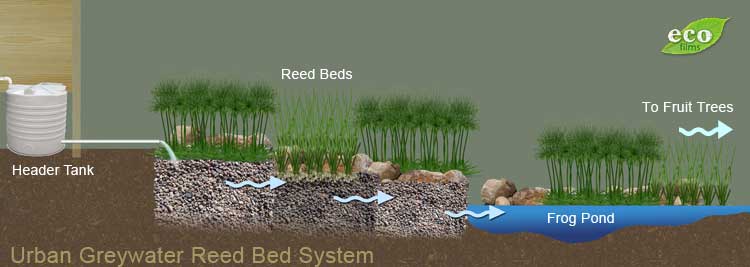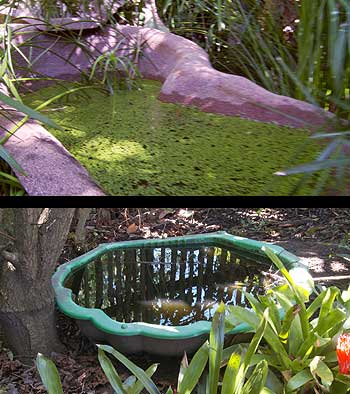Building an Urban Greywater Reedbed
Permaculture teacher Geoff Lawton scrambles through a clump of reeds perched over a some large boulders and gingerly steps over a pond choked with Duckweed and Salvinia floating on the surface. You can hear the frogs croaking in the background. Birds are singing in the trees. He peels back a clump of papyrus reeds to reveal another hidden frog pond.
You may think this is a scene taken from a wilderness somewhere in a thriving jungle. But its not. We’re in a suburban Sydney backyard. A yard no bigger than most you’ll find anywhere. But its not a normal backyard. Its a Permaculture garden with its own little wetland.
Building a wetland in your backyard is not something many people would ever consider – except if you’re into Permaculture.
Penny Pyett’s home has a wonderful grey-water reed-bed system that looks complicated at first but is so simple to design into your garden and the benefits are many.
Apart from encouraging native frogs and wetland creatures to return, its a channel for all household grey water waste. No dumping of water back into the storm water drain and out to sea here. Penny is using her waste water for productive ends. When the water is cleaned through a series of gravel reed beds and filtered through a series of frog ponds – it gets fed to her fruit trees.
Penny has got a food forest of productive trees that are also fed by the nutrient waste from ducks. Thats right! Ducks in the City. You need ducks to keep eating those fat little frogs you have growing in your reed bed – right? Thats all part of the Permaculture philosophy after all. But we’re getting ahead of ourselves here so lets jump back and get back back on track.
Lets take a closer look Penny’s greywater system and take a look at her design.
 All the greywater in the house is dumped into a header tank which is located under the house. In Penny’s case, it happens to be an old bathtub. The bathtub has a 45mm PVC pipe that runs underground to the desired spot for her three gravel reed beds. Course gravel is used to quickly soak any waste water and a series of thick reeds and boulders are used to hold the system in place should a sudden rain event or deluge occur.
All the greywater in the house is dumped into a header tank which is located under the house. In Penny’s case, it happens to be an old bathtub. The bathtub has a 45mm PVC pipe that runs underground to the desired spot for her three gravel reed beds. Course gravel is used to quickly soak any waste water and a series of thick reeds and boulders are used to hold the system in place should a sudden rain event or deluge occur.
Gravel
Any thick gravel is suitable preferably one that doesn’t have any limestone which will alter the pH. Wetland plants are designed to grow in waterlogged soils with very low oxygen levels. Most wetland plants are adapted to “pull oxygen out of the air” and diffuse it down through the roots creating little aerobic zones. This stimulates microbial activity and bacterial growth to occur. The bacteria will break down compounds suspended in the soil and help filter the water as it runs through the various gravel beds and out to the frog ponds. Microorganisms break down about 90% of pollutants and waste breakdowns in the gravel. The plants also act as a carbon source for microbe activity when they break down and decay.
What Reeds are suitable?
Plants able to be grown in permanent water swamps
- Persicaria lapathifolium Knotweed
- Ranunculus inundatus River Buttercup
- Phragmites australis Native Reed
- Restio tetraphyllus Tassel-rush, Tassel Cord-rush
- Triglochin microtuberosum Water Ribbons
Plants that are able to grow in fresh water swamps, creek and dam banks
- Carex appressa Tall Sedge
- Gahnia clarkei Tall Saw-sedge
- Gahnia melanocarpa Leafy Sedge
- Gahnia aspera Tufted Sedge
- Isolepis nodosa Knobby Club-rush
- Juncus kraussii Sea Rush
- Juncus usitatus Common Rush
- Lomandra longifolia Spiny-headed Mat-rush
- Dianella caerulea Blue FlaxLilly
- Crinum pedunculatum Swamp Lilly
- Cladium procerum Leafy Twig Rush
Frog Ponds
The grey water eventually drains into a small frog pond where small fish can also be added to keep the mosquito population under control. Penny Pyett likes to recycle a lot of materials thrown out by people back into her wetland. So discarded plastic children’s play pools and sand pits are collected and recycled by Penny into her wetland garden. Buried in the garden between thick reeds, they look natural and inviting. Water is constantly in play moving through the gravel and dipping from one large pond to another and so on. Eventually the water is returned clean and back into a swale that supports a food forest system. The end result is that you end up irrigating your garden every time you take a shower or wash the dishes. Nothing is wasted as the system takes care of itself.
Penny’s greywater reedbed system will be featured in The Urban Permaculture DVD out later in the year. Check it out.









Hello there
Im after a bit of info would be very greatful if you could help.
I have a shed i live in that has a slight slope of about 1m that runs down to dams at the back of my property. At the back of the damsis a national park that in the wet season is a paper bark tree wetland. I want to use a grey water system for my shower kitchen and laundry. I was thinking about the read bed system but sometimes in the summer with a lot of rain the areai was thinking about installing the system can flood. My guess is this would not be good as the untreated water would be washed stright into the flood water. Do you have any ideas on what i could do for my grey water. I do have power but it is a limited supply as it is solar so a system that did not involve power would be best.
thanks and really look forward to hearing from you
kind regards
Ryan
http://earthship.com/sewage-treatment
grey water treatment in house or glasshouse